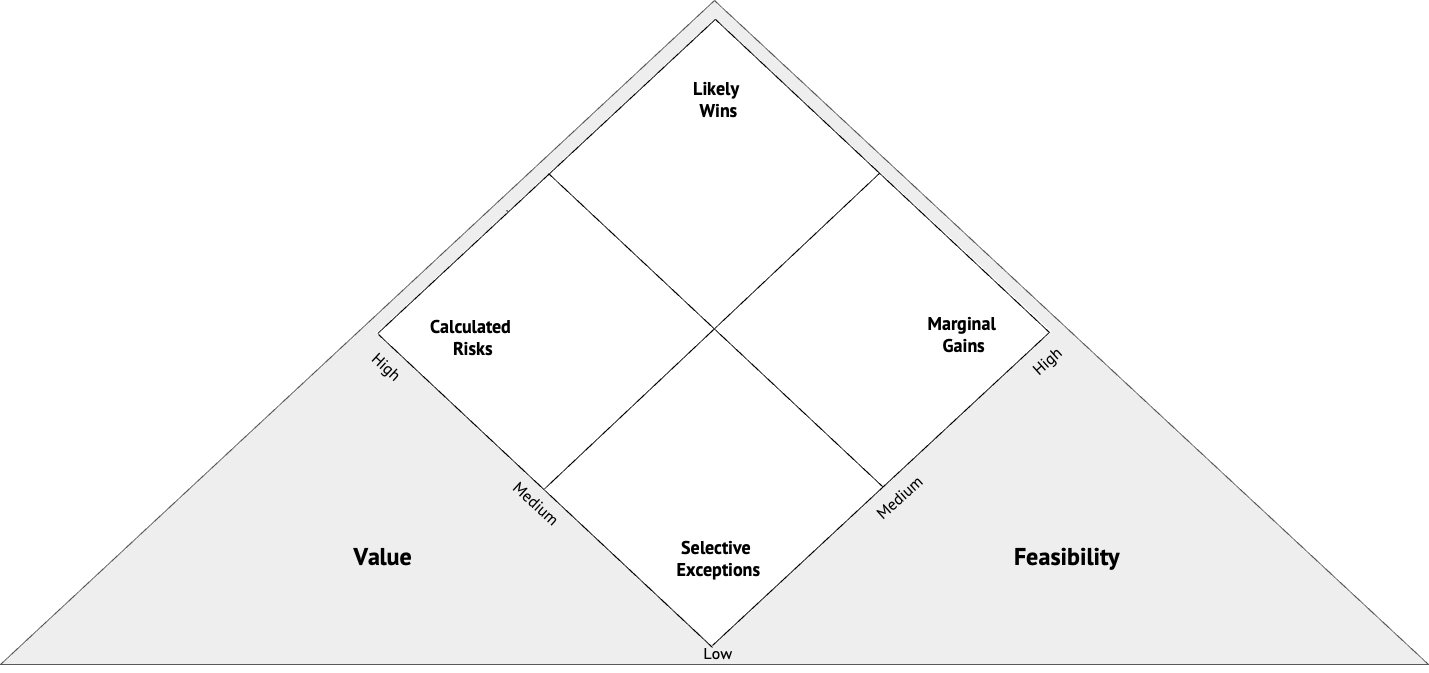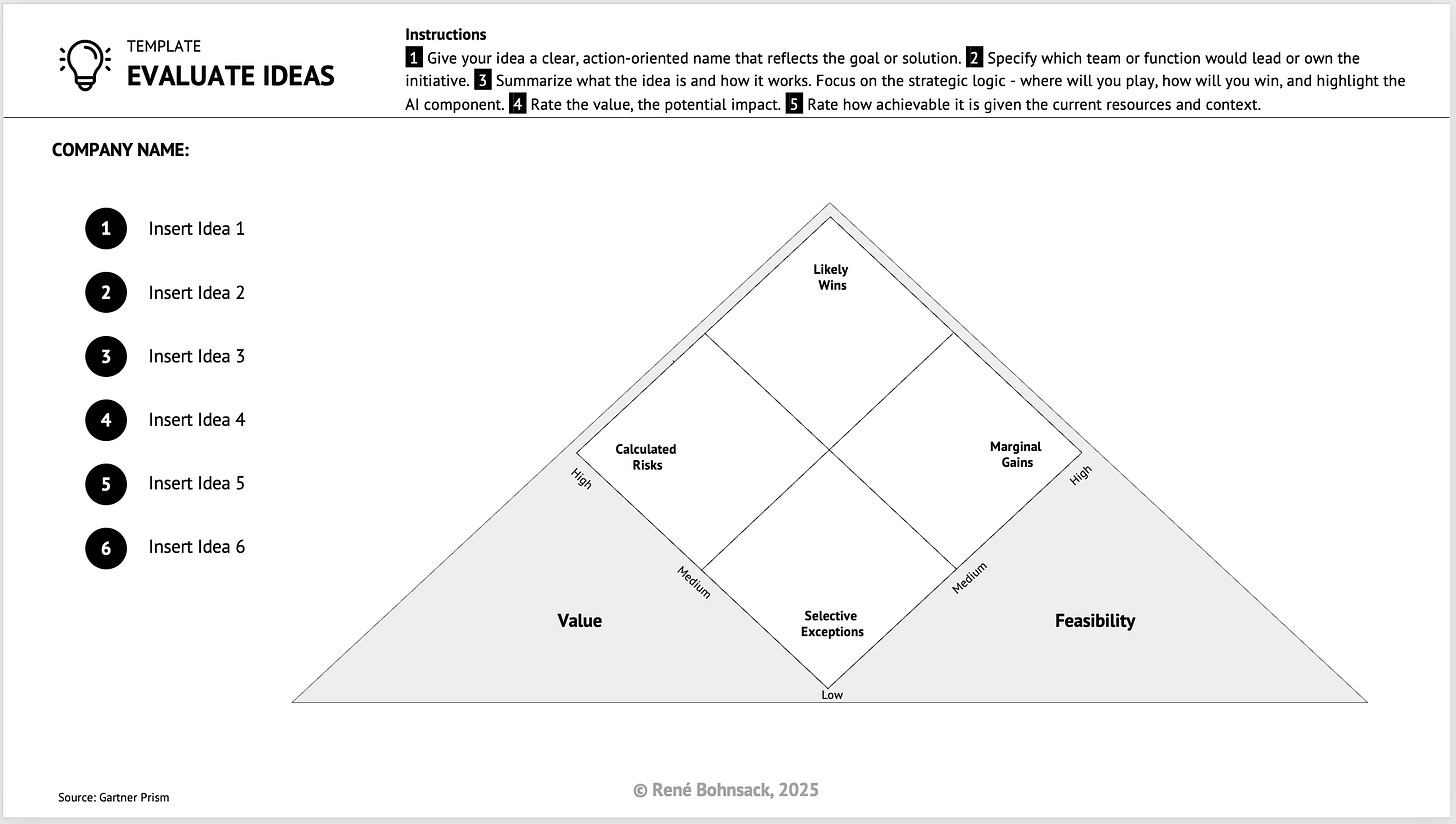From AI Ideas to Advantage: How Will We Win?
TL;DR
Identifying where to play is not enough. You must also define how you will win.
Leaders must move from “AI ideas” to a focused portfolio of strategic projects.
Each project must link to a clear source of advantage: speed, efficiency, intelligence, cost, or customer value.
The PRISM matrix helps you prioritize the right projects and avoid overcommitting to low-impact or high-risk ideas.
According to MIT’s 2025 State of AI in Business Report, 95% of GenAI pilots deliver no measurable ROI. Only 5% ever scale into production tools creating real value. This makes prioritization frameworks like PRISM indispensable.
In the first two parts of this series, we explored the foundations of AI strategy through the Play to Win framework. First, we looked at Winning Aspiration, the North Star that gives AI its purpose and direction. Without it, AI becomes little more than scattered pilots. Then, in Part 2, we turned to Where to Play, the tough but necessary choices about where to focus AI efforts and, equally importantly, where not to. Clarity here determines which battlegrounds will deliver meaningful value.
Now we arrive at the third question: How will we win? This is where ambition meets advantage. It’s not enough to know why and where to play; leaders must also define how AI will help them differentiate, compete, and sustain advantage. And this is where many organizations struggle.
Adoption Is Not Advantage
There’s a growing myth in business circles: that adopting AI automatically makes a company smarter, faster, or more competitive. It doesn’t.
The latest MIT 2025 State of AI in Business Report makes this painfully clear. Despite billions poured into AI, 95% of organizations report no measurable impact on their profit and loss (P&L) from generative AI. Even more striking: only 5% of enterprise pilots ever scale into production tools delivering millions in value.
In other words: launching AI pilots is easy. Turning them into business advantage is rare.
The scale of the problem is staggering. According to MIT, while 80% of enterprises investigate generative AI, only 20% move beyond pilots, and a mere 5% ever implement task-specific tools that create measurable business impact.
This “pilot-to-production chasm” shows why adoption ≠ advantage. Launching pilots is easy, scaling them into systems that move the P&L is rare. It’s the difference between experimenting and winning.
This is why the third question in the Play to Win framework - How will we win? - is so critical. Many AI initiatives are operationally interesting but strategically irrelevant. They demonstrate capability, but not advantage.
To truly win, you need more than technology adoption. You need a mechanism of advantage, a clear reason why AI makes you uniquely better at delivering value. And that requires ruthless prioritization.
What Winning Looks Like
At its heart, winning is about creating sustainable advantage. It’s not about winning in general but winning in the specific arenas you’ve chosen in your “where to play” decisions.
This means making tough choices about what you’ll do differently or better than competitors. Sometimes that’s a cost advantage: streamlining processes so deeply that you can offer lower prices or enjoy higher margins. Other times it’s a differentiation advantage: delivering unique experiences, superior quality, or insights that customers can’t get anywhere else.
As Lafley and Martin remind us, echoing Michael Porter, there are only two fundamental ways to win: by being the lowest cost provider, or by differentiating. But here’s the catch: you can’t do both. Trying to win in every way only dilutes your resources and blurs your priorities.
The strongest AI strategies connect three elements:
A clear aspiration,
A focused domain (where to play), and
A mechanism that makes you hard to copy.
That’s how companies move from a wall of pilots to real, measurable performance.
Why Pilots Fail
Why do so many pilots stall? The same MIT report shows the main barriers aren’t model accuracy or infrastructure. Instead, leaders cite workflow integration, user adoption, and lack of sponsorship as the biggest blockers.
In other words: AI doesn’t fail in isolation. It fails when it’s not embedded into how the business actually works. This is exactly why frameworks like PRISM are essential, they force organizations to balance ambition with feasibility, ensuring projects are not only valuable but executable.
From Ideas to Advantage
Most companies today don’t suffer from a shortage of AI ideas. The problem is prioritization. In one client workshop, leaders mapped out 12 potential AI projects across the business. Every department had something in motion. Every leader wanted resources. But when asked which project would create the most value this year, silence filled the room.
This is where a prioritization tool like Gartner’s PRISM matrix becomes invaluable. Originally designed as a portfolio management tool, PRISM (Portfolio, Review, Integration, Scoring, Management) offers a structured way to evaluate projects not just on potential value but also on feasibility. It pushes organizations to ask two deceptively simple questions:
Will this initiative deliver meaningful business value?
Do we realistically have the technology, talent, and organizational readiness to pull it off?
By plotting projects along these two axes, value and feasibility, PRISM creates four zones that reveal hidden truths about your portfolio:
Likely Wins (high value, high feasibility): These are your best bets. They deserve priority funding and focus.
Calculated Risks (high value, low feasibility): These are ambitious projects with high upside but barriers to execution. They may need pilots, partnerships, or staged investments to de-risk.
Marginal Gains (low value, high feasibility): Easy wins that may boost morale or efficiency but won’t move the strategic needle. Pursue only if cheap and non-distracting.
Selective Exceptions (low value, low feasibility): These ideas are often shiny distractions. They should be challenged, redesigned, or dropped.
Why does this matter for AI? Because without such a framework, companies either chase everything or double down on what’s easiest, neither of which leads to advantage. PRISM forces clarity. It reveals which projects deserve real investment, which should be put on hold, and which are drains on attention.
Case in Point: Lessons from Industry
In one of our programs, Drydocks World, a major player in the marine and offshore services industry faced the challenge many organizations encounter: too many AI ideas, not enough focus. Leaders identified a long list of potential projects, from predictive maintenance to digital twins. The challenge wasn’t a lack of ambition, but a lack of prioritization.
When they applied the PRISM matrix, the picture became clearer. Some initiatives, like predictive maintenance, emerged as high-value and highly feasible, ready to deliver business impact quickly. Others, like digital twins, held promise but required more maturity, investment, and cultural readiness to succeed. The process gave the leadership team a shared language to prioritize, sequence investments, and transform a scattered wish list into a coherent AI roadmap.
"With Play to Win Capstone, DryDocks identified many AI use cases poised to improve productivity across our operations. The AI Trends in Business workshop revealed innovations we’d never considered. The AI Balanced Scorecard workshop showed us how to use clear KPIs to implement AI in our organization successfully. Importantly, René’s energizing facilitation kept us all rowing in the same direction."
Hind Almasoum & Jeong Lee - DryDocks World
This experience reflects what many organizations discover: the problem is rarely a shortage of ideas. It’s the discipline to decide what comes first, and what must wait. PRISM brings that clarity.
Turning Ideas Into Impact
Every company has AI ideas. Few have a process to turn them into advantage. The shift happens when leaders stop asking, “Which tools should we try?” and start asking, “Which projects will help us win?”.
Meanwhile, employees aren’t waiting. MIT describes a growing “shadow AI economy” inside companies: employee use of generative AI far outpaces sanctioned adoption. This highlights a leadership dilemma. While organizations stall in pilots, their people are already experimenting and finding value. Without focus and governance, this grassroots adoption risks becoming fragmented, duplicative, or even non-compliant. Leaders who define how they will win with AI can channel this energy into aligned, scalable advantage.
Ask yourself:
Are we chasing what’s shiny, or what truly matters?
Have we chosen the ideas most likely to move the needle?
Are our teams aligned on how AI will help us win?
In the next part of this series, we’ll move to the fourth question in the Play to Win framework: What capabilities must be in place? We’ll explore how to turn ambition into capacity, and how to build the human, data, and tech foundation that an AI strategy truly needs (read here).
Until then: Which of your AI projects is most likely to help you win?






